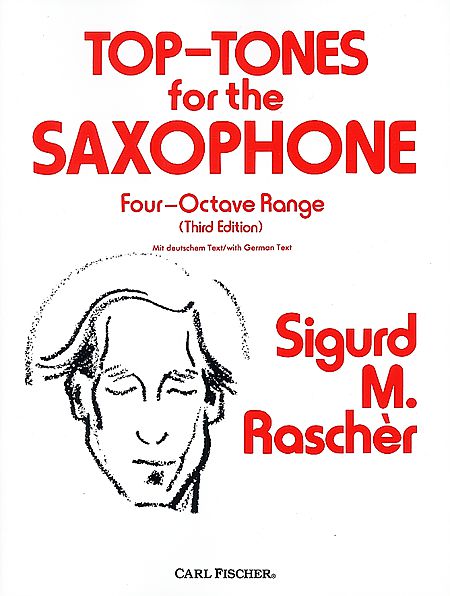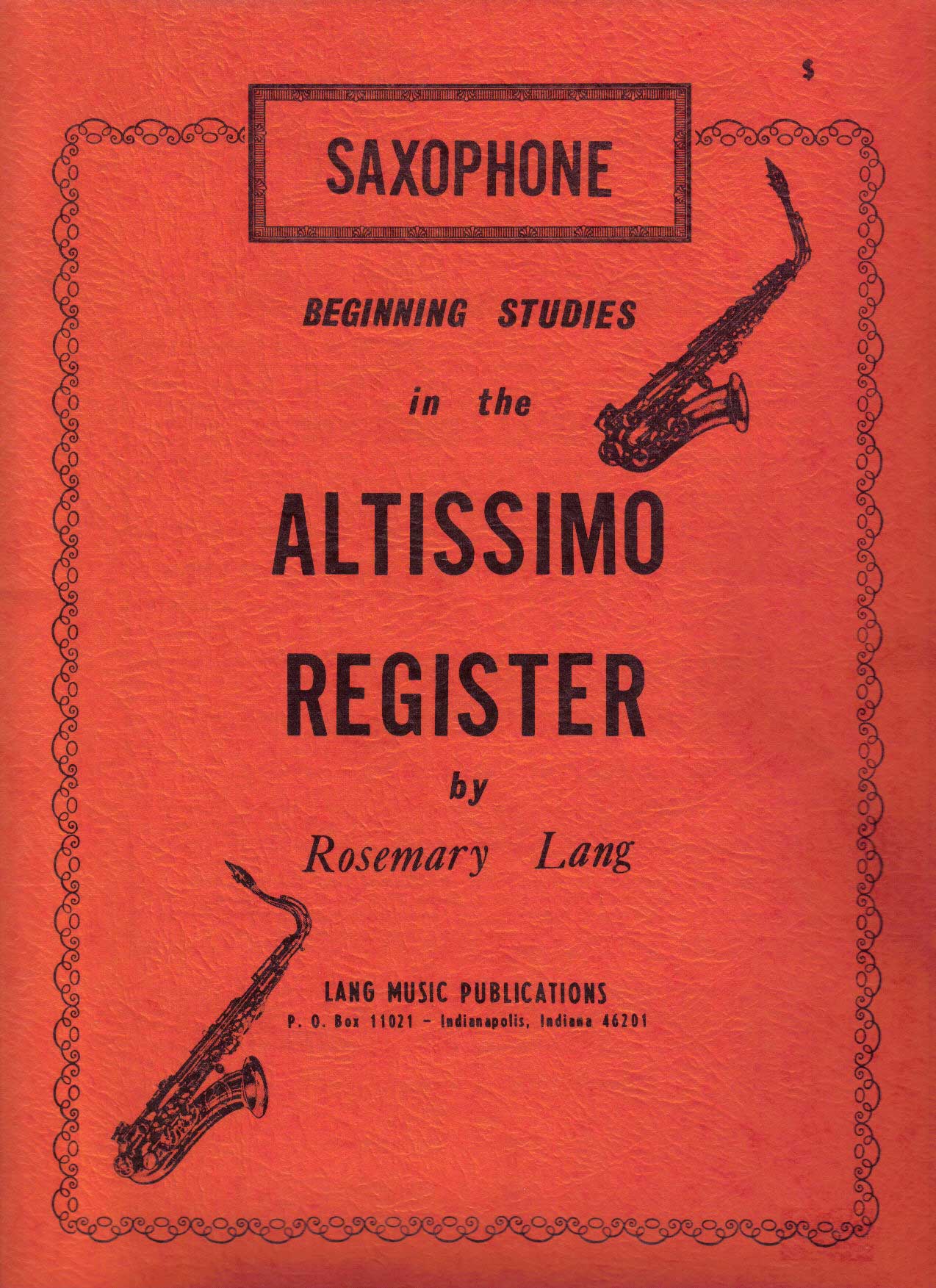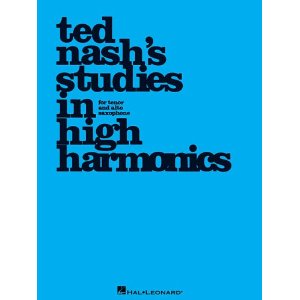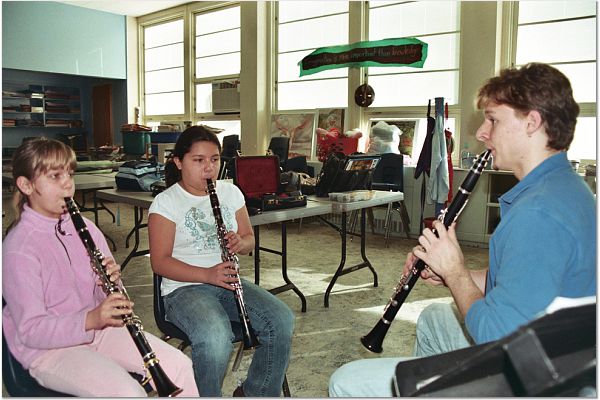From the Source: Joe Allard pt. 2
/A buddy of mine had this gem in his possession: the forward to Joe Allard: the Master Speaks.
Read MoreA buddy of mine had this gem in his possession: the forward to Joe Allard: the Master Speaks.
Read MoreI'm very happy to congratulate one of my students, Andrew Kreitner, on being chosen as lead tenor sax for Georgia's All-State Jazz Band. Andrew has constantly surprised me with his earnestness and sincerity. Good job to Andrew for this much deserved achievement.
Read MoreMy students have heard this before, but there's an old playbook being used when it comes to teaching saxophone tone. It needs to die a slow, horrible death...
Read MoreAnother awesome masterclass. This is Chris Potter at the Aebersold camp a couple summers ago. The best part of this is where Potter describes how he breaks down and works on language.
This is one of the best masterclasses I've ever seen. Dick Oatts essentially lays out everything you need to know as an improviser. It's a long one, but WELL worth the watch.
Read MoreHere are links to the GMEA website resources for All-State Band audition material for Middle and High schools. Chromatic scale ranges (required for all instruments) can be found by following the link to your age group and looking at the chart provided by GMEA.
There are 3 things on this and almost every audition, 1) Scales, 2) Etudes (aka prepared piece), 3) Sight reading. Scales and Etudes are listed below by grade then instrument.
After the first few lessons with a new student, inevitably they come in frustrated saying that their band director told them that they (and the entire sax section) are playing too loud. I tell them to calm down and do what their band director tells them. Then we talk about the “Why” and “How” of dynamics. And, in my opinion, band directors often seem to get it wrong when it comes to tone and dynamics with their saxophone section more than any other. I admit that I have, and I like, a louder sound. This doesn’t mean I can’t or don’t want to play soft, but I prefer to have, and believe musicians need, a sound that projects. I recently attended a master class with Jeff Coffin here in Atlanta and heard him talk about this very thing. (Disclaimer: I’m certainly not comparing myself to Jeff Coffin). Think about any time you’ve been to watch young kids play instruments in a group. Cousins’, brother’s, sister’s, niece’s, nephew’s concerts in their school gym. It wasn’t very loud was it? When you have new musicians on Flutes, Clarinets, Trumpets, Trombones, Bassoons, basically any instrument that’s not Saxophone, these instruments are not naturally loud for a beginning musician. While air production is consistent from instrument to instrument, it takes a lot of training of embouchure muscles to get a sound that projects on many of these instruments. The exact opposite is true of Saxophone.
Saxophone doesn’t require a muscular embouchure, at least if you follow the teachings of Joe Allard or possibly even Larry Teal. After embouchure, the only thing left is air production. This is where band directors fall into a trap without knowing it: Saxophonists have to first learn how to control their air and support their sound. This usually means putting LOTS of air into the horn. I equate it with the first time I hit a correct backhand in tennis. The instructor showed us how you have to hit through the swing. The first time anyone hits the tennis ball with the correct form, the ball goes over the fence and into the parking lot. We then were told to keep the form but to try and aim more accurately. THAT’S WHAT HAS TO HAPPEN WITH SAXOPHONE!! So many directors are interested in immediate balance and huge volume changes that young saxophonists do not have the capability to do well. Instead, everyone in the section bites down and backs off on air. This results in pitch and tone quality issues which is why their saxes sound so ‘bright’ or ‘tinny’, why they can’t articulate with speed and accuracy, and why they can’t play in the upper register or lower register, let alone play these registers in tune. Worst of all, the students learning the instrument are developing terrible habits and having a lousy time since they can’t play what’s on the page. It’s like giving a pointillist painter a roller to use and then telling them just to paint lighter. If you don’t have the proper base, in this case air control, you can’t start practicing subtlety.
My Advice: To get a great sounding sax section, students should start by doing overtones (the saxophone version of the brass section’s ‘lip trills’, although a very a different exercise). Then introduce dynamic long tones. And, directors and teachers, don’t worry about getting the right balance the first couple of months. Let the students build the warm, lush sound that the saxophone has, then teach them ‘how to aim’.
I get questioned all the time by my students about how to get a better sound. It's a great question and an important one at that. However, the worst thing that can happen is if someone has never even asked themselves "how do I work on tone?" If someone new to an instrument is using their ear when they play, really listening to themselves, they usually have a pretty good sound. This allows them to do all sorts of new music, new concepts, extended range and techniques, even if their embouchure and air stream aren't perfect. The flip side is when someone is fighting a 'bad' sound. They'll find that it holds them back from doing so much more on their instrument. Tone work should usually start off your practice session. It allows you to warm up, use air correctly before working on technical or musical aspects, and get mentally prepared for your practice session. Here's a list of Clarinet tone exercises that I've picked up over the years and a Saxophone version will follow shortly (but, feel free to reference "Ramon Ricker Overtone Exercises" in the meantime).
PDF of Clarinet Tone Exercises
 I know, everyone's wretched band director had them bring their instrument home everyday, not practice, then convince their parents to lie at the end of the week and sign this arbitrary sheet called a 'practice log' saying you had practiced an hour a day. This is truly unfortunate because this is the exact opposite of what a practice log should be. A practice log is an objective recounting of how much time you spent doing what in your practice time: no more, no less. Some people get really fancy with them, writing down detail after detail. That's not what I'm doing here. Above is a very simple practice log that I thought would be helpful for anyone looking to improve their practice routine, either by practicing more efficient, or by keeping better track of their own progress, or both. While you don't want the log to go on for pages, it is helpful to keep small notes as you progress (e.g. faster tempo markings, new exercises, etc.). Write down the individual times per exercise or concept and then add them up at the end to see how much you practiced in a day.
It's pretty self explanatory, but I'll take you through it. The first field listed is "Instrument", that's mainly for anyone who is a multi-instrumentalist and is juggling multiple practice schedules, in which case, a practice log is almost necessary to track of everything. The next is the date for the beginning of that week. Below that field are the goals for that week. This will help you keep track of your progress from week to week. You write down what you and your teacher have decided you'll work on for the week. The table is a breakdown of time spent on each category and total time per day. That's it.
I know, everyone's wretched band director had them bring their instrument home everyday, not practice, then convince their parents to lie at the end of the week and sign this arbitrary sheet called a 'practice log' saying you had practiced an hour a day. This is truly unfortunate because this is the exact opposite of what a practice log should be. A practice log is an objective recounting of how much time you spent doing what in your practice time: no more, no less. Some people get really fancy with them, writing down detail after detail. That's not what I'm doing here. Above is a very simple practice log that I thought would be helpful for anyone looking to improve their practice routine, either by practicing more efficient, or by keeping better track of their own progress, or both. While you don't want the log to go on for pages, it is helpful to keep small notes as you progress (e.g. faster tempo markings, new exercises, etc.). Write down the individual times per exercise or concept and then add them up at the end to see how much you practiced in a day.
It's pretty self explanatory, but I'll take you through it. The first field listed is "Instrument", that's mainly for anyone who is a multi-instrumentalist and is juggling multiple practice schedules, in which case, a practice log is almost necessary to track of everything. The next is the date for the beginning of that week. Below that field are the goals for that week. This will help you keep track of your progress from week to week. You write down what you and your teacher have decided you'll work on for the week. The table is a breakdown of time spent on each category and total time per day. That's it.
This table is simple on purpose. You want to spend as little time as possible 'book-keeping' and as much time as you can practicing. Remember, this is for you, not for someone else (so no need to lie). It's a way for you to objectively evaluate where you're at, how to set goals, how to proceed with your practice routine, and the results of those efforts.
I've included a link to Word document so that people can open it on their machine and edit it as need be:
I got these great sheets from Ben Wendel (of Kneebody) who's an old Eastman student of Raymon's. The first sheet shows 1) the harmonic series for Saxophone 2) the harmonic tendencies for Saxophone, Clarinet, and Flute, (those are the weird liny-charty things) and 3) 9 exercises for practicing the harmonic series. The second sheet shows the fingerings for playing major scales completely with harmonics. I've got some other Overtone exercise PDF's lying around that I'll be posting soon. Ramon Ricker - Saxophone Harmonics
**There has been an update to the All-State Middle School Etude for Saxophone. I've made the appropriate changes below** Here are links to the GMEA website resources for All-State Band audition material for Middle and High schools.
 I wanted to include, or at least make you aware of the video/book set titled Joe Allard: The Master Speaks. I believe it has been retitled Master Teacher: DVD's for Music Education presents NBC Artist Joe Allard, Clarinet & Sax Principles - Techniques That Work. (Jeez!!) Beware in purchasing this however. While Joe Allard was (and vicariously still is) the absolute source for production of tone on saxophone, this set was made when Joe was in his last bouts with Alzheimer's. Joe's concepts are incredible, but some don't really come across in the video. I suggest pairing it with the other books mentioned here. (Also, sax gossip: I'm told that the 'former student' that filmed the video took with Joe for a short period of time, quit because of personal difficulties with Joe, had some fairly 'not nice' things to say about him for a while after that, and then went back when Joe was fairly ill - some might say taking advantage - to film this video.)
I wanted to include, or at least make you aware of the video/book set titled Joe Allard: The Master Speaks. I believe it has been retitled Master Teacher: DVD's for Music Education presents NBC Artist Joe Allard, Clarinet & Sax Principles - Techniques That Work. (Jeez!!) Beware in purchasing this however. While Joe Allard was (and vicariously still is) the absolute source for production of tone on saxophone, this set was made when Joe was in his last bouts with Alzheimer's. Joe's concepts are incredible, but some don't really come across in the video. I suggest pairing it with the other books mentioned here. (Also, sax gossip: I'm told that the 'former student' that filmed the video took with Joe for a short period of time, quit because of personal difficulties with Joe, had some fairly 'not nice' things to say about him for a while after that, and then went back when Joe was fairly ill - some might say taking advantage - to film this video.)
The following is some stuff I found from www.DinoGovoni.com, got from my teachers, and some resources I've used in the past and present.
Great Books on Altissimo:
It's been my experience that these books are really great for a direction in the fingerings. I've worked with the Rosemary Lang book myself, which is fortunately BACK IN PRINT.

While I'm sure each of these books has it's own individual approach to the matter, be aware that every horn and person's body type/embouchure/set up is different and so the fingerings they present are not set in stone and change between different saxophones (Soprano, Alto, Tenor, Bari, etc.). I have a range up to what I call "altissimo double D" which would be in the saxophone's 5th octave basically by taking their suggestions and then making up the last few fingerings. You can, like most things, do a fairly quick Google search and find any number of altissimo fingerings. The best thing I did for my altissimo range was to not just do scales and patterns in the altissimo range ONLY. I took melodies, or bits of melodies (Star Eyes, Softly, Stella, etc.), children's songs (Frere Jacques, Mary Had a Little Lamb, etc.) and started them low enough so that only the top note was in the altissimo range and then kept working it up chromatically from key to key. One of the other things I did was take my Ferling 48 Etudes and read down most of the etudes in the altissimo register trying to maintain as much of the written material as I could (dynamics, articulations, tempo, etc.).
The most important thing that each of these books deal with extensively are the subject of over tones. A more in depth post on that later, but just wanted to throw that out there.
Books on other extended techniques:
Circular Breathing:
Multiphonics:
 There are tons of online resources on this subject. Many people have entire sites dedicated to this subject, so if you simply google "multiphonics saxophone" you'll get a good starting point with fingerings. Much like altissimo, these fingerings are very subjective. Even though you're getting a concrete fingering, it may not work or not work as well on your horn. When I first went looking for multiphonic info, I actually found some great fingerings out of a book of Michael Brecker transcriptions by Hal Leonard titled "The Michael Brecker Collection".
There are tons of online resources on this subject. Many people have entire sites dedicated to this subject, so if you simply google "multiphonics saxophone" you'll get a good starting point with fingerings. Much like altissimo, these fingerings are very subjective. Even though you're getting a concrete fingering, it may not work or not work as well on your horn. When I first went looking for multiphonic info, I actually found some great fingerings out of a book of Michael Brecker transcriptions by Hal Leonard titled "The Michael Brecker Collection".
Other than that, I've used my teachers as resources, YouTube videos of known artists are always helpful, and chatting with fellow musicians. I know we're all always looking for a way to get one step closer to 'our' tone so I hope these resources help. Since these are not the only things out there, if anyone else out there has other resources they'd like to add leave your suggestions in the comment box below.
One of the fundamental ways that someone develops a good sound on their instrument is by listening to a bunch of artists that have good sounds. I realized a while back that while I practice and teach Clarinet I did not have a simple 5 or 10 list of names that I could just shoot off if any of my students asked for recordings to check out. So, I e-mailed one of my old Clarinet teachers, Andy Stevens, for a list just in case there were other doublers out there that were having the same issue. Andy is the Bass Clarinetist for the Colorado Symphony Orchestra, Professor of Clarinet at University of Denver's Lamont School of Music, and I have him to thank for this list: The following are great artists for the Mozart and Weber Concertos
Great artist for Weber & Mozart Concertos and the Concerto by John Corigliano:
Contemporary Performers:
Good European Clarinetists
My ALL-TIME favorite Clarinetist, introduced to me by Andy:
I'd like to add some Jazz Clarinetists to the list as well:
 As you probably already know from reading my bio, I've been playing saxophone since I was six years old. That means I've been through a lot of reeds, mouthpieces, music, horns, and most importantly, teachers. I thought I could provide some tips on how to find a teacher based on what I've learned over the past few years.
As you probably already know from reading my bio, I've been playing saxophone since I was six years old. That means I've been through a lot of reeds, mouthpieces, music, horns, and most importantly, teachers. I thought I could provide some tips on how to find a teacher based on what I've learned over the past few years.
First, have a goal in mind of what you want to learn or what you are interested in musically. Then you want to make sure you have the right goal for a teacher. You want to find someone who has your musical interests in mind and the pedagogical skill to meet those interests. Do you want to learn to be the best jazz improviser you can be? Do you want to study classical repertoire? Or, do you just want to start playing an instrument and see where things go? Usually you can find that the best teachers can help no matter what you want to pursue. You don't want to do like I did and basically fall into the nearest studio, go through 2 or 3 teachers over about two and a half years, and finally, after lots of time and money spent, you find the best one in town.
Contact at least a handful of people as possibilities or for a list of references to other teachers, especially people that are NOT in your area. One of the best ways to start your search for the best teacher is to call or e-mail the professors for your instrument at the major colleges in your state, preferably with the best music programs. If you can study with them, great! But, since these are college professors, many times you can expect that they don't accept beginners into their studio, their studio is full, or they charge a high lesson fee. They will however, usually provide you with a great list of references.
After you've contacted all of the colleges with major music programs in your state (this shouldn't take long - usually only 4 or 5 e-mails), you'll see certain names pop up multiple times. Start with these names by doing an internet search, see what they're qualifications are, check out their playing, etc. You should always check the person's musical background no matter what organization they belong too. KNOW WHAT YOU'RE GETTING YOURSELF INTO.
There are some main qualities you want from your private teacher. First and foremost, you want to make sure that they enjoy teaching. There are a good number of musicians that are good players but haven't honed their ability to teach just yet. Secondly, that they teach in a way that you see, hear, and feel results in your playing. Some of the people recommended may be current students or recent graduates. This may seem worrisome when you've just started playing, you don't know who's out there or who to trust. Whether they be an experienced veteran or just starting out, what you're looking for is the same.
Having taught privately while still in school and knowing people that did as well, you'll find people that are great teachers, are great with kids, have a real love for music, and most importantly a love for teaching. However, college students may still be getting a handle on their own teaching style, but are usually more of a bargain, can be more laid back, and are sometimes more flexible with when they teach.
Another good way to gauge the kind of teacher they are and the effort they put into the development of their students is to check out how they communicate with their students. Do they communicate via e-mail, phone, etc.? Do they answer questions on the practice material in between lessons? How do they set goals for your playing? How do they structure lessons and what do they focus on? Do they allow you to record your lessons or have a way of doing that themselves? Do they have a website, even a site with extra practice/helper material?
If you're looking for a teacher for your kid, many times their band director will flat out KNOW who are the best private teachers. Check with the elementary, middle, AND high school directors just like with the college professors. Eventually you'll get names that come up again and again.
Chances are, unless you do your homework and come into contact with the right people at first, you'll probably go through at least one teacher before finding the best one for you. Don't fret though, the more you research and the more people you talk to the easier it will be. And don't forget, most of the time a teacher is just a guide. You'll find the more time you spend working, the better you'll get.
Teachers in the Atlanta and southern Georgia area that I have studied with and would recommend as a good starting point are: